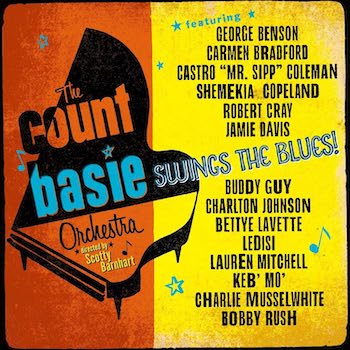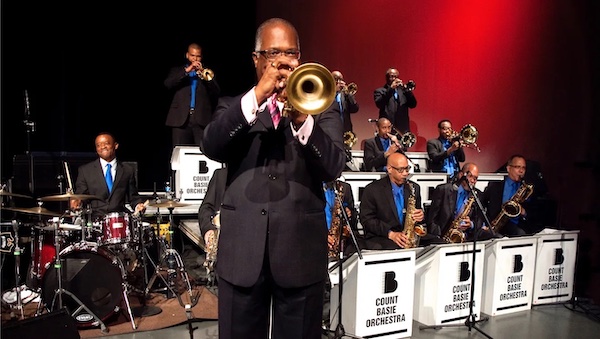Jazz Album Review: “Basie Swings the Blues” — Blues-Soaked Big Band Jazz
By Allen Michie
It’s good to hear the Basie band stretch. But it’s even better to hear them exult the blues with their own time-honored style leading the way.
Basie Swings the Blues – The Count Basie Orchestra (Candid)
It must be nice to have the Count Basie Band play for your private wedding.
According to Scotty Barnhart, the leader of the Count Basie Orchestra (Basie himself died in 1984),
In March of 2020, we were playing a private wedding reception on the very day that COVID-19 shut down nearly the entire western world insofar as travel was concerned…. After we had played Quincy Jones’ arrangement of “Fly Me to the Moon” for the lovely bride and groom on their first dance, the groom approached the stage to ask me if he could sit in with us. Normally, that means one of two things — the person can really play, or they can’t and just want to show off in front of their friends…. I told the groom he could sit in with us and after retrieving his guitar and joining us on stage, I asked what he might like to play and he said, “How about some blues?” I said sure, “What key?” He said, “It doesn’t matter to me.” Right then I knew something major was about to happen. I could feel it. I called the key of G to the guys and counted off a medium tempo blues and what happened over the next few minutes was one of the most incredible things I had ever heard in my life. The groom played the living heck out of the blues on his guitar and sounded like all of the great blues guitarists rolled into one. With the saxes, trombones, and trumpets improvising riffs behind him, that was the moment when I finally heard what our recording should sound like. It was electrifying! I just had no idea it would all culminate three years later in Basie Swings The Blues.
The authenticity of any ghost band is often questioned, but there’s something deeply true to the essence of the Count Basie Orchestra in this troupe, a resonance that goes all the way back to their roots as an offshoot of the Bennie Moten big band in 1933. Young, ambitious, and talented, Count Basie had the musical instincts of a Kansas City bluesman. In 1935, Basie’s band was doing a radio broadcast from Kansas City’s Reno Club, and they found themselves with some time to fill. They started improvising what became known as a “head arrangement” — the section leader comes up with a riff, the rest of the section harmonizes it and memorizes it, and the other sections fill it in and complement it with other riffs. According to Basie, “We hit it with the rhythm section and went into the riffs, and the riffs just stuck.” Basie called it the “One O’clock Jump,” and it became his biggest hit and signature tune.

What happened at that wedding some 85 years later sounds like it was another head arrangement. (Incidentally, how perfect is this for a wedding moment? Isn’t a head arrangement a perfect metaphor for starting a new life together?) The members of the band didn’t need to be told how to do it — the seasoned pros, no doubt hired for their ability to play with precision and swing through exacting charts, just drew on it naturally from the Basie band DNA. And the nucleotides holding together that band’s DNA aren’t C, G, A, and T, they are B, L, U, E, and S.
Basie Swings the Blues is a collection of one-off sessions with many of today’s great blues artists, with “blues” defined as you’d see it catalogued in your local record store: Buddy Guy, Charlie Musselwhite, Shemekia Copeland, Bobby Rush, and others. The experiment here is to reconcile multiple styles of the blues. The early Basie band historically represents a swinging kind of Kansas City jump blues often featuring the great blues shouter Jimmy Rushing (“Sent for You Yesterday”). From 1954 and occasionally up through the 1980s, baritone singer Joe Williams brought a freer and more gut-bucket blues style to the band (“Every Day”). In 1977, Basie hired Dennis Rowland, another baritone who brought a jazzier swing back to the band’s blues. So, even within the band’s history, you can find more than one style of the blues.
Each of those Basie blues styles is represented here. Castro “Mr. Sipp” Coleman shouts/sings his way through “Let’s Have a Good Time” behind the riffing horns, much like Jimmy Rushing. Jamie Davis, a regular performer with the Count Basie Orchestra, has Joe Williams’s baritone and some of his vocal mannerisms on “Look What You’ve Done.” Bettye Lavette swings “Stormy Monday” hard the way Dennis Rowland would, adding her wise and weathered voice.
Of course, there are other tracks where the band meets the guest artists more than halfway. Bobby Rush invites the band to “Boogie in the Dark,” and they hit a driving shuffle groove. The tight trumpets and silky sax section are a strong contrast to Rush’s sandpaper voice and loose-limbed phrasing. Whether the pairing works is a matter of taste, but it’s certainly different from the Basie band’s usual sound.
Mr. Sipp’s edgy delivery on “Dirty Mississippi Blues” pulls the band into a looser groove, drawing it more into the feel of the slow-stomping shuffle. A touch of reverb on the vocals helps create more depth — it makes it all sound a bit less studio-clinical. “Down Home Blues,” with Keb’ Mo’ and Lauren Mitchell, finds a balance between a rocking blues and swinging jazz. It’s great to hear Mo’ singing some real blues rather than nostalgic front porch pop songs. Lauren Mitchell, whose voice has been described as a “velvet freight train,” deserves to be better known. They’re a fine match, and the arrangement gives the horns more expressive licks and smears to work with.
At times, though, the well-intentioned matchups don’t quite connect. Some guest vocalists are giving it their all, but a big band can sometimes come off as if it’s performing a number from a Broadway show about the blues rather than the blues itself. For example, on paper “I’m a Woman” looks like it would be a very promising track. Shemekia Copeland on vocals, Charlie Musselwhite on harmonica, and Buddy Guy on guitar, with lyrics by Koko Taylor, deliver a feminist answer to Muddy Waters’s “Mannish Boy.” I’m sorry to say it drags. Guy gives an uncharacteristically laconic solo, Musselwhite seems disconnected (probably due to overdubs), and Copeland is powerful as always, but she’s showboating here. Sometimes a horn section is just what a blues song needs to elevate it, but sometimes a whole big band can weigh it down.

Trumpeter Scotty Barnhart, leader of the Count Basie Orchestra. Photo: courtesy of the artist
Not surprisingly, the two instrumental tracks are excellent. George Benson, who can channel the legendary Basie guitarist Freddie Green when he needs to, kills it on “Rock Candy,” a jump tune written by Benson’s former employer Jack McDuff. The addition of a Hammond B3 organ (Basie himself was an occasional organist) kicks this up to the next level. The horn soloists get a chance to dig in and get to bask in the spirit more than on most other tracks. This is a reminder of how good the 1990 album Big Boss Band — Benson’s return to straight-ahead jazz with the Basie ghost band — was. It was a commercial confection, but it was great to hear Benson uncork it over such powerful swinging support. “Rock Candy” will hopefully start some talk about a Big Boss Band: Volume 2.
The other instrumental track is “The Patton Basie Shuffle,” featuring Memphis guitarist Charlton Johnson, a former member of the Count Basie Orchestra. While it’s a fine track on its own merits, it’s a bit of a head-scratcher. Johnson sounds nothing like Charlie Patton (which is not surprising, because no other human being does either). The slick, up-tempo shuffle is entirely removed from Patton’s country blues aesthetic. Bandleader Barnhart writes in the notes that it’s a “nod to an imagined Count-Charley Patton encounter,” which is kind of like imagining a Steely Dan-Mahalia Jackson encounter. In any case, it gets the imagination moving about other Basie/blues combinations that could have been. This record makes me miss James Cotton, who had a big band of his own, and who would have loved being included here. Basie’s own longtime trombonist Al Grey, a master of the blues on plunger trombone, would have had a grand old time on this record. Mr. Sipp’s guitar on “Let’s Have a Good Time” can’t help but make you imagine how great B.B. King would have sounded with the Basie band roaring behind him. (Fortunately, we do have a whole album of the Count Basie Orchestra with Ray Charles, Ray Sings, Basie Swings, even if it was stitched together in the studio with the band playing in 2003 behind live tracks recorded by Charles in 1973.) Stevie Ray Vaughan’s jazzy shuffles, Otis Spann’s boogie piano, T. Bone Walker’s Charley Christian-like guitar solos … so many great “expanded editions” of Basie Swings the Blues must be streaming somewhere in the great beyond.
The trick here is for the mighty Count Basie Orchestra, which can be an absolute powerhouse live and unleashed, to not find itself reduced to the role of a horn section. That does happen from time to time on Basie Swings the Blues, as it probably should, because that is true to the tradition of Chicago blues. But the Basie band is a different animal from Roomful of Blues or Tower of Power, and it inevitably carries with it its own traditions of blues-soaked big band jazz. Not every singer or instrumentalist belongs in that sacred place in front of the Count Basie Orchestra. Not because they don’t deserve to be, but because it sometimes makes a national treasure sound like something other than itself. It’s good to hear the Basie band stretch. But it’s even better to hear them exult the blues with their own time-honored style leading the way.
Allen Michie works in higher education administration in Austin, Texas. He’s the moderator of the Jazztodon.com instance on Mastodon and the Miles Davis Discussion Group on Facebook. You can read an archive of his essays and reviews allenmichie.medium.com.
Tagged: Basie Swings the Blues, Count Basie Orchestra
